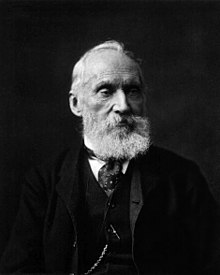William Thomson, 1st Baron Kelvin, OM, GCVO, PC, PRS, FRSE (26 June 1824 – 17 December 1907)[5] was a British mathematician, mathematical physicist and engineer born in Belfast.[6] Professor of Natural Philosophy at the University of Glasgow for 53 years, he did important work in the mathematical analysis of electricity and formulation of the first and second laws of thermodynamics, and did much to unify the emerging discipline of physics in its modern form. He received the Royal Society's Copley Medal in 1883, was its President 1890–1895, and in 1892 was the first British scientist to be elevated to the House of Lords.[2]
Absolute temperatures are stated in units of kelvin in his honour. While the existence of a lower limit to temperature (absolute zero) was known prior to his work, Kelvin is known for determining its correct value as approximately −273.15 degrees Celsius or −459.67 degrees Fahrenheit. The Joule–Thomson effect is also named in his honour.
He worked closely with mathematics professor Hugh Blackburn in his work. He also had a career as an electric telegraph engineer and inventor, which propelled him into the public eye and ensured his wealth, fame and honour. For his work on the transatlantic telegraph project he was knighted in 1866 by Queen Victoria, becoming Sir William Thomson. He had extensive maritime interests and was most noted for his work on the mariner's compass, which previously had limited reliability.
He was ennobled in 1892 in recognition of his achievements in thermodynamics, and of his opposition to Irish Home Rule,[7][8][9] becoming Baron Kelvin, of Largsin the County of Ayr. The title refers to the River Kelvin, which flows near his laboratory at the University of Glasgow's Gilmorehill home at Hillhead. Despite offers of elevated posts from several world-renowned universities, Kelvin refused to leave Glasgow, remaining until his eventual retirement from that post in 1899.[5]Active in industrial research and development, he was recruited around 1899 by George Eastman to serve as vice-chairman of the board of the British company Kodak Limited, affiliated with Eastman Kodak.[10] In 1904 he became Chancellor of the University of Glasgow.[5]
His home was the red sandstone mansion Netherhall, in Largs, which he built in the 1870s and where he died. The Hunterian Museum at the University of Glasgow has a permanent exhibition on the work of Kelvin including many of his original papers, instruments, and other artefacts, such as his smoking pipe.
https://en.wikipedia.org/wiki/William_Thomson,_1st_Baron_Kelvin

No comments:
Post a Comment